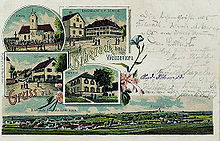Roggenburg, Bavaria
Roggenburg | |
|---|---|
 | |
Location of Roggenburg within Neu-Ulm district  | |
| Coordinates: 48°16′N 10°13′E / 48.267°N 10.217°E | |
| Country | Germany |
| State | Bavaria |
| Admin. region | Schwaben |
| District | Neu-Ulm |
| Government | |
| • Mayor (2020–26) | Mathias Stölzle[1] |
| Area | |
• Total | 27.41 km2 (10.58 sq mi) |
| Elevation | 512 m (1,680 ft) |
| Population (2023-12-31)[2] | |
• Total | 2,863 |
| • Density | 100/km2 (270/sq mi) |
| Time zone | UTC+01:00 (CET) |
| • Summer (DST) | UTC+02:00 (CEST) |
| Postal codes | 89297 |
| Dialling codes | 07300 |
| Vehicle registration | NU |
| Website | www.roggenburg.de |
Roggenburg is a municipality in the district of Neu-Ulm in Bavaria in Germany.
Roggenburg is known for the Roggenburg Abbey, which is used today by the Premonstratensians. An environment and culture center with an overregional commuting area is located near the abbey.
Geographical location
The municipality lies in the region "Donau-Iller" in central Swabia, approximately 30 km southeast of Ulm and 40 km north of Memmingen. The districts Roggenburg, Biberach and Meßhofen are located on the Biber river, the districts Ingstetten, Schießen and Unteregg at the Osterbach, while Schleebuch is located between these two rivers.

Politics
The municipal council has 14 members plus the major.
| ÜWV Schießen | FW Meßhofen/Roggenburg | WG Biberach | WG Ingstetten | Total | |
| 2002 | 5 | 3 | 4 | 2 | 14 seats |
References
- ^ Liste der ersten Bürgermeister/Oberbürgermeister in kreisangehörigen Gemeinden, Bayerisches Landesamt für Statistik, 15 July 2021.
- ^ Genesis Online-Datenbank des Bayerischen Landesamtes für Statistik Tabelle 12411-003r Fortschreibung des Bevölkerungsstandes: Gemeinden, Stichtag (Einwohnerzahlen auf Grundlage des Zensus 2011).
External links
- "Roggenburg, Bavaria: History of the coat-of-arms" (in German). Haus der Bayerischen Geschichte.
- Official statistics



